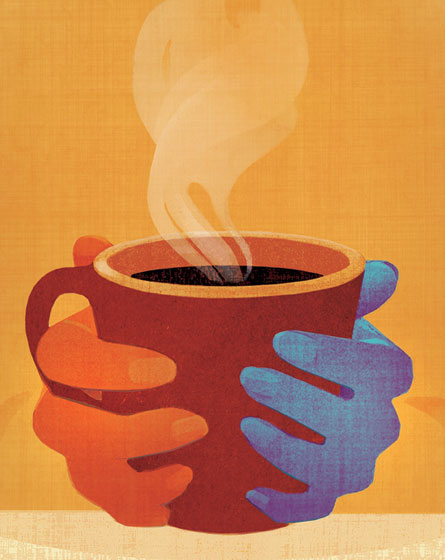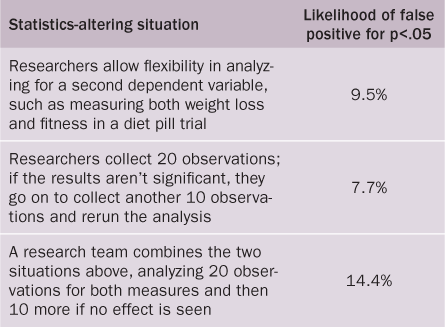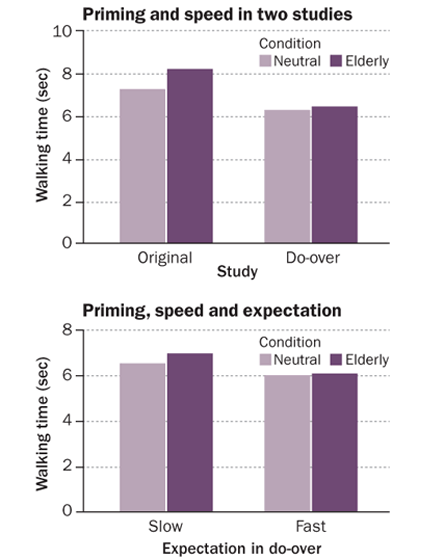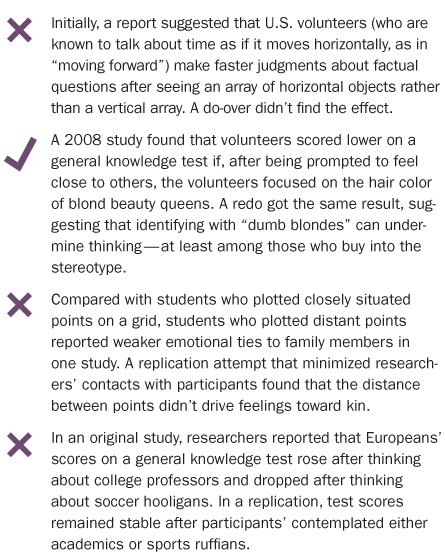The Hot and Cold of Priming
Psychologists are divided on whether unnoticed cues can influence behavior
It’s prime time in social psychology for studying primes, a term for cues that go unnoticed but still sway people’s attitudes and behavior.



Primes have been reported to influence nearly every facet of social life, at least in lab experiments. Subtle references to old age can cause healthy college students to slow their walking pace without realizing it. Cunningly presented cues about money nudge people to become more self-oriented and less helpful to others. And people holding a hot cup of coffee are more apt to judge strangers as having warm personalities.
Over the last 15 years, many social psychologists have come to regard the triggering of personal tendencies by unnoticed cues as an established phenomenon. Priming may even inspire innovative mental health treatments, some argue.
Yale University psychologist John Bargh likens primes to whistles that only mental butlers can hear. Once roused by primes, these silent inner servants dutifully act on a person’s preexisting tendencies and preferences without making a conscious commotion. Many animals reflexively take appropriate actions in response to fleeting smells and sounds associated with predators or potential mates, suggesting an ancient evolutionary heritage for priming, Bargh says. People can pursue actions on their own initiative, but mental butlers strive to ease the burden on the conscious lord of the manor.
Despite the fondness that a lot of social psychologists have for studying primes, long-simmering skepticism about this research has now reached a boiling point. Investigators of decision making, memory and other mental faculties, collectively known as cognitive psychologists, say that bedrock priming effects vanish when independent researchers carefully repeat the experiments. Selective reporting of data in priming papers, a practice that occurs in other areas of psychological research, undermines the statistical strength of many published findings, researchers asserted in January in San Diego at the annual meeting of the Society for Personality and Social Psychology.
One new report suggests that volunteers consciously pick up on what’s expected of them in priming trials by reading researchers’ body language and other unwitting, nonverbal prompts. A handful of studies, unpublished but posted on a new website, that attempted to minimize direct contact between participants and experimenters find no signs of several previously reported priming effects. Scientific misgivings about priming have apparently strengthened a grassroots movement in psychology to make research more accessible and transparent via the Internet.
Critics consider the power of consciously directed decisions to be more important than priming. Occasional unconscious influences on thoughts and actions are weak and short-lived, this perspective holds. Behavior typically changes slowly and with much effort, explaining why many priming effects that just barely pass statistical muster vanish with further testing.
“The big idea in social psychology is that social behavior is unconsciously influenced by cues in the environment, but the evidence for that idea needs to be much better,” says cognitive psychologist David Shanks of University College London.
Walk this way
Much of the current fuss over priming concerns Bargh-directed experiments described in an influential 1996 paper. College students unscrambled sentences that, for one group, contained words related to stereotypes about the elderly, such as wrinkle and Florida. Upon finishing, participants who had read old age–related words took about a second longer to walk down an exit hallway than peers who had perused age-neutral words.
A string of unnoticed, stereotypical references to the elderly slyly evoked thoughts of physical deterioration with age, prompting healthy young adults to slow down, Bargh proposed (SN: 10/30/99, p. 280).
Cognitive psychologist Stéphane Doyen of Université Libre de Bruxelles in Belgium has long felt that something was out of step with Bargh’s findings. A team led by Doyen reproduced Bargh’s slow-walk effect, but only when students recruited to lead the experiments were first briefed to expect such responses from participants who read age-related words.
Volunteers primed with elderly stereotypes didn’t change their pace when the experiment’s leaders had no knowledge or expectations about the trials (or when experimenters were told to expect that primed volunteers would walk faster), the team reported online January 18 in PLoS ONE. Taken together, these results suggest that old-age references coaxed students into a leisurely strut only when experimenters provided inadvertent encouragement to slow down, perhaps via facial expressions or body language, Doyen proposes.
Although volunteers reported no awareness of having read words about old age in Bargh’s experiment, they may still have been consciously aware of the priming, Doyen says. After testing, primed participants in Doyen’s study were shown pictures of four people from different social categories and asked to pick one that could have been related to words used in scrambled sentences. An image of an elderly person was chosen markedly more often than an athlete, an Arab or a physically handicapped individual, suggesting participants were at least somewhat aware that they’d read words about old age.
People may find it difficult to articulate themes associated with words in scrambled sentences even when faintly aware of those themes. “A lot of precautions should be taken to test for unconscious priming effects,” Doyen says.
Even simple experimental actions can give away the game to volunteers. Consider evidence that people judge hills to be steeper after donning heavy backpacks. Investigators initially suggested that a weighty prime on the spine makes terrain look tougher to negotiate, so nearby hills take on added slant.
In a new study directed by psychologist Frank Durgin of Swarthmore College in Pennsylvania, an experimenter told some participants not to let wearing a backpack affect their judgments. Estimates of a hill’s angle were comparably accurate whether these volunteers toted a pack or not. What’s more, many backpack wearers, regardless of what they’d been told, admitted after the trial that they thought the load had been intended to make the hill seem steeper.
Shanks says such findings suggest that recruits for psychology experiments quickly draw conclusions about what’s expected and how to behave, regardless of any unintended signals from researchers. That makes it devilishly hard to study social behavior. Durgin’s study illustrates the need to account for participants’ unspoken assumptions about the purposes of priming trials, Shanks says.
File-drawer rescue
It’s a truly steep climb to cart unsuccessful replications of other scientists’ studies up Mount Publication. Major journals make no secret of preferring papers that describe novel advances and attract media attention, says psychologist Hal Pashler of the University of California, San Diego. Not surprisingly, failed replications often get filed and forgotten, meaning studies that support priming have gotten more attention than those that don’t.
Pashler has conducted five unpublished do-overs of priming studies. None have yielded previously reported effects. Contrary to Bargh, Pashler has found that students walked down a hallway at about the same pace whether or not they had unscrambled sentences containing words associated with old age. Pashler suspects that his ineffectual primes partly resulted from efforts to avoid swaying volunteers’ behavior and partly reflect the original study’s statistical weakness.
Pashler’s investigation remained unknown until January, when a website he cofounded (PsychFileDrawer.org) started posting unpublished replications of psychological studies. Researchers can upload and compare experimental repeats, discuss their findings and even vote on studies they most want to see conducted a second time. “It would be useful if everyone would post their unpublished results online so we could get a more unbiased picture of the priming data,” Pashler says. He predicts that many priming effects will crumble under further scrutiny.
In priming studies, as in much psychological research, researchers try to reject a “null hypothesis” that, say, volunteers’ average walking speed will be the same after exposure to age-related and neutral words. If the measured difference between groups is at a 5 percent level of statistical significance, for example, it is generally assumed to mean that in five of 100 instances, evidence favoring rejection of a null hypothesis would actually be a statistical fluke.
At the San Diego meeting, psychologist Joseph Simmons of the University of Pennsylvania in Philadelphia argued that researchers often arbitrarily exclude data considered unreliable, alter experimental conditions that don’t work as planned and otherwise fiddle with what goes into a final report. Cherry-picking data in this way masks the statistical weakness of published studies and raises doubts about many reports of statistical significance, he said.
For decades, a string of influential psychologists have recommended disposing of null hypothesis significance testing altogether, calling the approach an unscientific ritual that should be replaced by testing specific predictions. In the February Theory & Psychology, psychologist Charles Lambdin of Intel Corp.’s campus at Ronler Acres in Hillsboro, Ore., calls significance testing psychology’s “dirty little secret.”
A 5 percent significance level merely indicates that chance may not be responsible for slowed walking among readers of elderly references, Lambdin says. But the likelihood of any proposed explanation for the results remains unknown. In Bargh’s study, slow walking might be due to priming, subtle coaxing by experimenters, volunteers’ guessing the purpose of the study, a combination of all three or something else entirely. A rejected null hypothesis sulks in the corner, saying nothing about the relative merits of any potential reason for its existence.
Subliminally yours
Still, Bargh regards his studies, and the last 30 years of priming research, as solid science. Reams of statistically significant results reflect the mind-changing power of unconscious cues, even if much remains to be learned about how primes work, he says.
As for Doyen’s proposal that Bargh’s team subtly prompted responses from volunteers, Bargh dismisses it: “We went out of our way to control for experimenter effects in our 1996 studies.” Experimenters who dealt with volunteers knew nothing about the study’s aims or materials and never saw scrambled sentences, which were handed to participants in sealed envelopes.
Stereotypes about the elderly are stronger in the United States than in Belgium, so it’s not clear that age-related words had anything to activate in the minds of Doyen’s Brussels-based volunteers, adds psychologist Hans IJzerman of Tilburg University in the Netherlands. IJzerman studies primes but was not involved in either Bargh’s or Doyen’s investigations.
In addition to priming volunteers with senior stereotypes embedded in scrambled sentences, Bargh’s 1996 paper included an experiment aimed at priming underlying assumptions about black people. Previous studies had found that these racial stereotypes include attributing a propensity for hostility to blacks.
White and nonblack minority students working on a computer task reacted more angrily to a minor provocation if images of black people’s faces, as opposed to white people’s faces, had flashed on the screen during the task. Each face, followed by a pair of crosshatched patterns intended to block awareness of having seen a face, appeared for a fraction of a second. Conscious, hostility-related thoughts and feelings triggered by unconsciously perceived black faces prompted surly behavior, Bargh proposes.
In this case, volunteers weren’t aware that they had seen faces of black people at all (unlike slow-walking students who knew they had seen words but were purportedly unaware of how loaded the words were).
Comparable effects from both aware and subliminal priming bolster Bargh’s confidence that stereotype references in scrambled sentences truly were modifying people’s behavior.
Subliminal primes, such as the flashing faces, offer a way to untangle how priming can sway some volunteers but not others, says psychologist Chris Loersch of the University of Missouri in Columbia. In an upcoming Social Cognition, he and psychologist Keith Payne of the University of North Carolina at Chapel Hill report that primes alter behavior only when participants are encouraged by researchers to treat thoughts and feelings activated by a subliminal cue as self-generated.
In an experiment inspired by Bargh’s slow walkers, Loersch and Payne measured how rapidly volunteers read experimental instructions on a computer screen before and after subliminal presentations of words related to speed or slowness.
During subliminal priming, letter and number strings flashed on the screen just long enough to be noticed. Some volunteers were told that these strings would distract them from any thoughts starting to form. Among these individuals, average reading pace quickened in response to fast primes and decelerated after slow primes. Loersch suggests that participants mistook prime-induced urges to speed up or slow down for their own ideas, believing their thoughts were powerful enough to survive experimental distractions. Taking ownership of primed thoughts prompted behavior consistent with those thoughts — reading instructions either faster or slower.
Reading rates remained unchanged, though, when participants were told that letter and number strings contained powerful, irresistible subliminal messages. In this case, volunteers may have refused to heed urges to speed up or slow down, feeling that those urges were alien notions implanted during the trial. “We may be priming people to trust or distrust what they remember,” Loersch says.
Some real-life situations up the chances of mistaking externally influenced thoughts for self-generated ones, he adds. Priming may flourish, for example, when people have to make quick decisions in complex settings.
Doyen takes a dim view of subliminal research. “It’s already difficult to obtain priming effects with weakly perceived cues in scrambled sentences,” he says. “I doubt subliminal priming effects will stand up to replication.”
Warm showers for cold hearts
Whether Doyen and others buy into priming’s effects or not, Bargh is poised to move the dispute outside the lab.
Bargh suspects that physical warmth and other health-related cues, delivered by image or text to smartphones or via virtual reality headsets, can supplement treatments for anxiety, depression, eating disorders, addictive behaviors and learning disabilities.
Lonely, rejected guys and gals instinctively seek out physical warmth without realizing what they’re doing, Bargh and psychologist Idit Shalev of Ben-Gurion University of the Negev in Beersheba, Israel, reported in the February Emotion.
“People maintain emotional equilibrium in mundane ways,” Bargh says. “These home remedies can be adapted for mental health treatments.”
Bargh has applied to several funding agencies for grants to study possible applications of priming to clinical work. One proposal would examine whether some alcoholics prefer drinking hard liquor because it provides a rush of physical warmth that temporarily lessens loneliness and fires up conviviality. If so, warm packs or other high-temperature cues could be tried as aids in alcoholism recovery programs, Bargh suggests.
So far, his proposals have been turned down by funders. A “wave of negativity” about priming effects may partly account for grant reviewers’ coldness toward Bargh’s research proposals, remarks psychologist Joseph Cesario of Michigan State University in East Lansing. Cesario, who studies how responses to the same prime vary in different physical settings, says that priming critics are threatened by evidence that complex thinking doesn’t require conscious thought.
Shanks admits having felt uncomfortable at first with claims that a few unobtrusive words or images can reshape behavior. Ensuing studies, rife with what he sees as flaws, have only solidified his misgivings. Included are the recent findings on unconscious links between social and physical warmth.
Without independent confirmations, Shanks sees no future for clinical applications of warmth primes. “It’s puzzling that so little attention has been devoted to replicating priming results,” Shanks says. Until such replications are done, he recommends serving no prime before its time.
Repeats and defeats
Attempts to replicate studies of unconscious influences on mind and behavior often don’t get published. Some researchers say that publicizing details on such research repeats (some below) would allow a fuller evaluation of priming.
